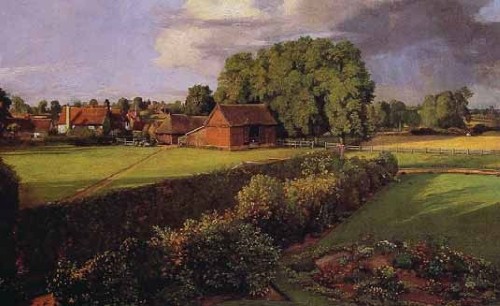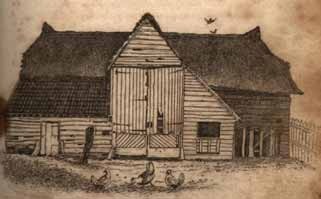BUILDINGS IN THE EAST ANGLIAN LANDSCAPE – AS SEEN BY JOHN CONSTABLE

Golding Constable’s Flower Garden painted by John Constable, 1815.
The East Anglian countryside has not always evolved slowly – in fact, sudden waves of prosperity which have struck our region from time to time have resulted in transformations. One of these was in about 1600, a time known nationally as ‘The Great Rebuilding.’ Another was during the Napoleonic War period, at the beginning of the 19th century. Illustrations of the landscape and townscapes of East Anglia before and during this period are not numerous, but the evidence they give is startling. A good starting point in understanding the countryside around the Stour and Colne Valleys during the 18th century would be to study these two maps: Hodskinsons’ Map of Suffolk published in 1783, and Chapman & Andre’s Map of Essex published in 1777. They show the following:
• many greens and tyes which as a result of 19th century enclosure no longer exist today,
• a pattern of roads which has since been rationalised and upgraded,
• small settlements scattered all over the landscape. Overlying this unfamiliar 18th century landscape there were picturesque farmstead groups in widely-varying conditions of maintenance or decay. The coming of the wars with France resulted in escalating grain prices, the ploughing up of pastures, and the rebuilding of farmsteads. At the centre of each was a large barn, either new or redeveloped. Clustered around it would be buildings serving this new arable economy, which was producing great wealth for landowners and entrepreneurs. These farmstead groups would include stables, granaries and cartlodges, all necessary for handling the increased crop production. The farmhouse would be rebuilt, replastered, or refronted with a white brick facade and sliding sash windows. In fact we can visualise two worlds which were separated by only a few decades. In the first, Tudor and Jacobean farmsteads continued in use with a little adaptation when funds allowed. In contrast, the second world was characterised by rebuilt or expanded farmsteads, surrounded by large cornfields which had taken the place of a patchwork of small meadows and hedgerows. Artists of the period around 1800 enjoyed depicting romantic scenes just as they do today. I have chosen three illustrations which have unconsciously given us a powerful record of a landscape and its buildings that had so far escaped the transformation of the Napoleonic Wars:- • A view of Long Melford Green by William Poulter, c.1790. Most of the houses in this unique watercolour are still standing today, but they are almost unrecognisable because of 19th century alterations. The painting corrects many of the misapprehensions held today about Suffolk and Essex decorative traditions. There are no bright pink, yellow or green colourwashed plastered walls on any of these houses. Such things were unknown until the later 19th century – and the colours recently applied on many historic houses have no part in the vernacular tradition. All the plasterwork is white. Only one of the houses in the picture has a brick front, and even this may be a refronting of a timber-framed house. Nearly all the ‘Georgianized’ houses in the East Anglian countryside date from the Napoleonic Wars or later – the fashion had barely started in the 18th century. There is one obvious outbuilding in the picture with boarded walls – a barn or stable placed at right-angles near the centre. The boards are black, but coal tar had not arrived in East Anglia in 1790 and so this must have been a carbon-black pigmented distemper. • ‘Golding Constable’s Flower Garden’, by John Constable, 1815. An upstairs window in Golding Constable’s house in the village of East Bergholt was the vantage point for the artist. Beyond the garden wall was a meadow with a trimmed path across to a farmstead. The buildings in the picture include a medieval farmhouse with whitewashed plastered walls, and a thatched 3-bay barn with boarded walls. These walls are painted with a bright red ochre. We have discovered that at least 30% of the boarded farm buildings in our area were painted this colour in the 18th and early 19th centuries before the arrival of coal tar. Others were black or unpainted, and some were ‘blue’, which seems to have been achieved with nodules of chalk suspended in carbon black pigment – an optical blue. The subject of these pigment colours – fascinating and highly relevant – urgently needs more research including microscopic analysis of paint samples. This is the way to be sure exactly what Constable was painting in his beloved countryside. • ‘The Red Barn at Polstead: A Correct View of the Exterior’, by an unknown artist, c.1830. The murder of Maria Marten in this barn by William Corder on the 18th May, 1827 captured the imagination of the public throughout England. This accurate illustration shows that the barn was thatched with boarded walls, and was in poor condition. The artist was intent on correcting inaccuracies concerning the identity of the barn, and the details of the story of the murder which were in circulation. The Staffordshire Pottery models of the barn which were made in great numbers at the time show that these boarded walls were bright red. It was demolished soon afterwards, apparently because people were stealing pieces of timber as souvenirs and the owners were becoming distressed by all the unwanted attention. The boarding in the foreground is very pale: white was not normally used as an external treatment of boarding and this bright effect would not be used as an illustration of blackness. We can conclude that the artist was looking at red boarding. The building is a highly recognizable example of a Suffolk threshing barn in every detail. The barn is illustrated and the whole story is discussed on the website of St. Edmundsbury Borough Council. A commentator speculates that the name ‘Red Barn’ might have referred to the partial tile roof-covering, but this is improbable because the barn is mainly thatched, and tiles were commonplace and unremarkable. Red boarding would be as striking as it is today, but we now know that it was far from unique on boarded farm buildings.

A view of Long Melford Green painted by William Poulter, c.1790.
By examining paintings and prints in this way, and by carefully scrutinising the standing buildings that go back to the period, it is possible to reconstruct the 18th century countryside. Questions should be asked about current attitudes to the maintenance of buildings and landscapes that we have inherited, but bearing in mind that time cannot stand still. Should we be encouraging owners to paint their plastered walls only in white, and their boarded farm buildings in red or black distemper? Should houses be plaintiled and outbuilding roofs thatched? Should we be reconstructing wooden fences, sowing rough pasture, and leaving wasteland along road sides? The answer surely is ‘sometimes’. Otherwise we might forget what it is that makes the Stour and Colne Valley countryside – as for instance it was in the time of John Constable – so very attractive to modern eyes. A fashion for brightly colourwashed plastered walls took hold in the 1970s, encouraged by the Planning Authorities. I noted at the time that there was further encouragement from manufacturers of cement-based paints who added new ‘historic’ colours to their ranges. More recently, the advice from our conservation officers is to restrict the palette to earth colours, in particular red and yellow ochres. Converted barns are today invariably clad in black boarding, bringing to mind Henry Ford’s offered choice of paint colours for his new cars in the 1920s! Colour on buildings is extremely important. The choice in each case needs to be built on sound research. Those of us who look closely at historic buildings will have to take responsibility for not publishing our findings widely enough in the past. For the moment I would like to make a plea – if in doubt – for white-painted plaster, and for renegotiating the colour options for the boards on converted barns.
Philip Aitkens
Philip Aitkens is a Historic Buildings Consultant and it was he who discovered the true significance of Abbas Hall in Cornard. He has written two articles in earlier CSCA magazines. He helped us overcome planning obstacles when we were wanting to build on to our Grade 2 Listed House in 1998.

The Red Barn at Polstead painted by an unknown artist, c1830.
